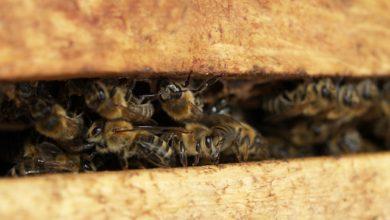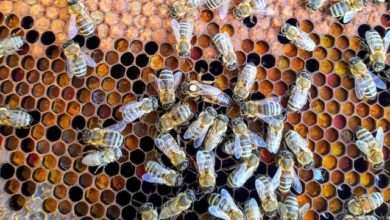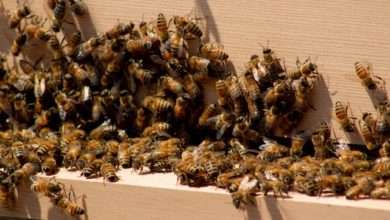State Beekeeping Facts
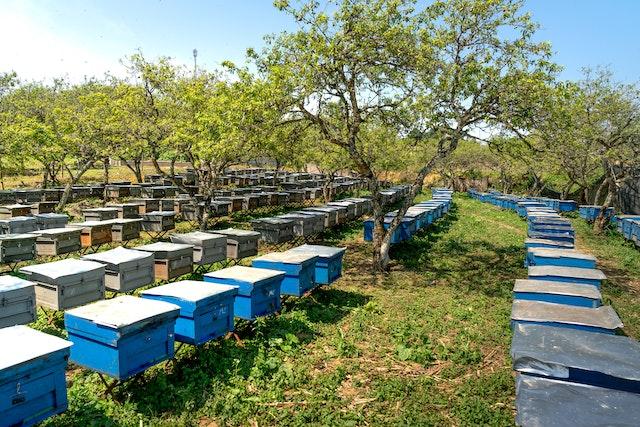
More than 200,000 beekeepers are there in the United States. 1.48 million pounds of raw honey were produced in 2020 by 2.71 million bee colonies, according to USDA statistics.
The average American consumes about 1.51 pounds of honey annually, according to the National Honey Board.
Here is a list of interesting state beekeeping facts:
ALABAMA: Cotton honey is a typical honey kind in Alabama. Light in color and delicate in flavor, cotton honey is a type of honey. Honey bees help cotton plants reproduce by pollinating them, thereby assisting in the production of the fabric required to construct a variety of apparel items. You can thank the bees the following time you put on your preferred t-shirt.
ALASKA: In Alaska, it is normal practice for beekeepers to start a new colony of honey bees every spring rather than attempting to preserve their existing colony over the winter.
ARIZONA: Arizona features a number of flowering plants, such as acacia, mesquite, and catsclaw, that provide great nectar sources for honey despite the state’s sometimes desert-like climate. Bees also collect nectar in the fall from plants such as Indian buckwheat, burrow weed, poppies, daisies, and poppies.
ARKANSAS: The honey bee, Arkansas’ state insect, is required for pollination of the apple bloom, the official flower of Arkansas.
CALIFORNIA: The largest almond grower in the world is California. The pollination of California’s almond crop requires migratory beekeepers to transport thousands of honey bee colonies there each year.

For pollination alone, the crop needs to be brought in more than twice as many colonies as are already in California. In terms of producing honey, California continues to hold the record. Setting a Guinness World Record in 1976, Santa Cruz resident Ormond R. Aebi removed 404 pounds from a single hive.
COLORADO: If your honey bees are within 25 feet of a residence in Aurora, Colorado, you are required to surround them with a 6-foot-high fence.
CONNECTICUT: Connecticut produces a wide range of natural honey varieties, including buckwheat, blueberry, raspberry, and wildflower varieties. In the US, there are more than 300 different kinds of honey, and there are more than 3,000 different kinds in total. The color, flavor, and perfume of the honey are influenced by the nectar source from which it was made. There is a variety for any occasion because there are so many different kinds.
DELAWARE: In 1936, the Delaware State Beekeepers Association was established.
FLORIDA: With 12,736,000 pounds of honey produced in 2012, Florida was the third-highest-producing state.
GEORGIA: It is against the law to make beekeeping in Georgia illegal, according to a long-standing governmental regulation. Honey bees are responsible for pollinating peaches, one of Georgia’s most significant crops.
Georgia is also the home of Buzz Beekeeping Supplies.
HAWAII: More than 150 years ago, honey bees were first introduced to Hawaii. Honey production and queen breeding are two of Hawaii’s main beekeeping skills. Beekeepers buy queen bees from queen breeders to place in their hives. Queen breeders are people who cultivate queen bees. In the beekeeping sector, they have a significant impact. Lehua, Macadamia, Hawaiian Christmas Berry, and Wileaiki Blossom are among the extremely distinctive honey varieties that are produced in Hawaii.
IDAHO: In Idaho, alfalfa is essential as a source of honey. Honey from alfalfa has a wonderful flavor and is either white or extra-light amber in color.
ILLINOIS: Since at least 1820, honey bees have existed in Illinois. Although they were introduced by early settlers in the 1600s, honey bees are not indigenous to America.
The Charles Dadant family first started selling honey and beeswax in nearby Illinois communities in 1863.
INDIANA: Over 609,000 pounds of honey are produced annually by honey bees in Indiana alone.
IOWA: In Iowa, apples are the most common fruit produced. For the pollination of apples, honey bees are essential. Ten completely formed seeds can be found in a fully pollinated apple. In addition to collecting pollen from apple flowers, honey bees also gather nectar. With a delicate, delicious flavor, apple blossom honey is a light amber color.
KANSAS: The Northeastern Kansas Beekeepers Association was founded in 1948, and the honey bee has been the official state insect of Kansas since 1976.
KENTUCKY: The legendary horse race known as the Kentucky Derby is held in Kentucky. Why do horses and honeybees have anything in common?
From flowers, honey bees gather pollen. As a source of protein, they consume this pollen. It turns out that pollen is occasionally given to horses as a protein source as well. Pollen can aid in conditioning, preserving a healthy blood cell count, and muscle development in horses, though it is recommended to consult a veterinarian before doing so.
LOUISIANA: The honey bee is the official insect of Louisiana, and you may purchase a license plate that reads “rescue the honey bee” to support honey bee health studies there.
MAINE: Over 60,000 acres of land are used to cultivate wild blueberries in Maine. Every year to pollinate the blueberry harvest, migratory beekeepers transport about 55,000 hives to Maine. A beehive might produce an extra 1,000 pounds of produce on one acre, according to field research.
MARYLAND: A honey standard has been established in Maryland. Maryland offers pure honey that has been packed in accordance with statutory regulations.
MASSACHUSETTS: Alfalfa, apple blossom, blackberry, blueberry, buckwheat, goldenrod, and raspberry are just a few of the unusual honey kinds available in Massachusetts. The flavors range from delicate and light to powerful and rich, and the hues range from light golden to dark brown. Be sure to give them all a try.
MICHIGAN: Due to the fact that blueberries are one of Michigan’s top ten cash crops, honey bees play a crucial role in the pollination of blueberries in Michigan.
MINNESOTA: For the purpose of learning more about honey bees and their maintenance, the Department of Entomology at the University of Minnesota set up a bee lab. Pollination, or the act of moving pollen from flower to flower so that it can be fertilized and grow fruits and vegetables, is the most crucial task for honey bees. Nearly one-third of our food is pollinated by honey bees, and this activity contributes $19.2 billion to the US economy each year.
MISSISSIPPI: One beehive in Mississippi typically yields 98 to 105 pounds of honey annually, and the state as a whole generates between 1 and 1.5 million pounds of honey.
MISSOURI: Soybeans are one of Missouri’s principal crops. In Missouri alone, soybean crops brought in more than $2.2 billion in 2010. Pollinators of soybeans include honey bees. The crucial work performed by these little insects has a significant effect on the nation’s economy and state.
MONTANA: Montana is one of the top ten states in the United States for producing honey, and white clover honey is produced there.
NEBRASKA: The number of beehives in Nebraska is somewhere between 40,000 and 50,000. A broad sector of the economy is beekeeping. The honey bees can be actively supported by everyone, from small children to the elderly.
By growing bee-friendly plants like herbs or clover, you may do a lot to aid honey bees. Supporting neighborhood beekeepers by purchasing their products is another fantastic way to contribute. Consider starting your apiary as a last resort. Any level of beekeeping is possible, whether it’s just for enjoyment or as a job.
NEVADA: The main cash crop of Nevada, alfalfa, is pollinated by honey bees.
NEW HAMPSHIRE: In New Hampshire, there are numerous types of honey that can be found, including alfalfa, apple blossom, blackberry, buckwheat, goldenrod, raspberry, and wildflower. It’s really expensive to get this honey. To generate just 1/12 teaspoon of honey, a worker bee must labor her entire life. Give a honey bee a shout-out the next time you indulge in one of the various honey varieties.
NEW JERSEY: One distinctive form of honey that honey bees produce in New Jersey is black locust honey.
NEW MEXICO: Honey bees pollinate a wide variety of plants in New Mexico, despite the state’s predominantly desert-like climate. The pollination of plants by honey bees is essential for the fertilization of all plants, including Emory’s baccharis, firewheel, golden crownbeard, and New Mexico olive.
NEW YORK: On the rooftops of restaurants and other buildings, beehives are frequently kept in New York.
NORTH CAROLINA: The beekeeping industry is thriving in North Carolina. The state’s crops, including cucumbers, strawberries, watermelons, squash, and peppers, will receive the necessary pollination assistance thanks to its nearly 13,000 beekeepers and 100,000 hives.
NORTH DAKOTA: North Dakota produced 34,115,000 pounds of honey worth $64,553,000. This made it the state with the most honey production in 2012.
OHIO: The Lithopolis Honeyfest is an annual event held in Ohio with the goals of promoting honey consumption, advancing beekeeping industry education, and increasing public understanding of the use of honey bees in agricultural pollination. The event is usually “sweet,” so if you are around, be sure to swing by.
OKLAHOMA: Honey in Oklahoma is frequently found in the taste wildflower. Depending on which flower’s nectar the honey bee collected, honey has a particular flavor.
OREGON: In Oregon, you are required to register your honey bee colonies if you have more than five of them.
PENNSYLVANIA: This is where the current American Honey Queen is from. The American Honey Queen Program was launched in 1959 with the aim of promoting beekeeping and the consumption of honey. Our intention is still the same, and we want to visit every state in the US this year.
RHODE ISLAND: Honey bee pollination is necessary for the production of apples, one of the principal crops grown in Rhode Island.
SOUTH CAROLINA: In South Carolina, there is a sizable tobacco crop. Since ancient times, people have smoked tobacco. As they tend to their hives, beekeepers also utilize smoke to assist calm the bees and shield them from stings.
SOUTH DAKOTA: The honey bee is the official insect of South Dakota, which came in second place for producing honey in 2012.
TENNESSEE: In Tennessee, there are 37 local beekeeping associations. An excellent method to learn more about beekeeping and determine whether it is good for you is to join a local beekeeping group.
TEXAS: Texas is a state where mesquite honey is frequently found. It is distinctive but subtly sweet honey.
UTAH: Utah is a beehive state. Did you know that bees spontaneously construct hexagonal-shaped cells inside their hive? It is one of the strongest structures seen in nature, and bees always construct it diagonally at an angle of 9 to 12 degrees.
VERMONT: The pollination of clover blossoms by honey bees is necessary because clover honey is well-liked in Vermont.
VIRGINIA: In Virginia, watermelon is a significant crop that bees pollinate. Did you know that it requires 12 bees to produce just 1 teaspoon of honey throughout their whole lives? All of that laborious labor.
WASHINGTON: Washington State is home to a rare type of honey called carrot honey.
WASHINGTON D.C.: The White House first introduced beehives in 2009. In order to prevent the President’s dog from consuming them, the bees are now kept on top of a big stand.
WEST VIRGINIA: Goldenrod, autumn olive, basswood, and tulip poplar are just a few of the honey species that are produced in West Virginia. Liquid honey, chopped comb honey, chunk honey, and creamed honey are just a few of the various varieties of honey that are offered. Honey is a substance that can be used in a wide variety of ways and flavors.
WISCONSIN: Beekeepers in Wisconsin have the option to apply to have their honey deemed pure so that it can be labeled as “Wisconsin-certified honey” on the packaging.
WYOMING: Each bee colony in Wyoming produces an average of 66 pounds of honey, and there are about 48,000 of them. Beekeepers from the state frequently travel throughout the country to pollinate crops for the benefit of the entire beekeeping business.
FAQs
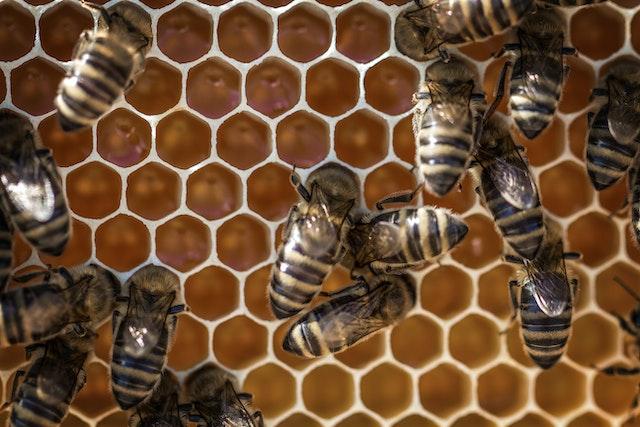
How many beekeepers are in the United States?
In the United States, there are around 212,000 beekeepers.
Is beekeeping considered agriculture?
On the basis of accepted terminology and usage, beekeeping (officially known as “apiculture”) is categorized as an agricultural activity. Through regulation and taxation, the Federal and State governments also treat beekeeping as part of agriculture (or farming).
What are the top 5 honey-producing states?
1.) North Dakota
2.) Montana
3.) California
4.) South Dakota
5.) Florida


